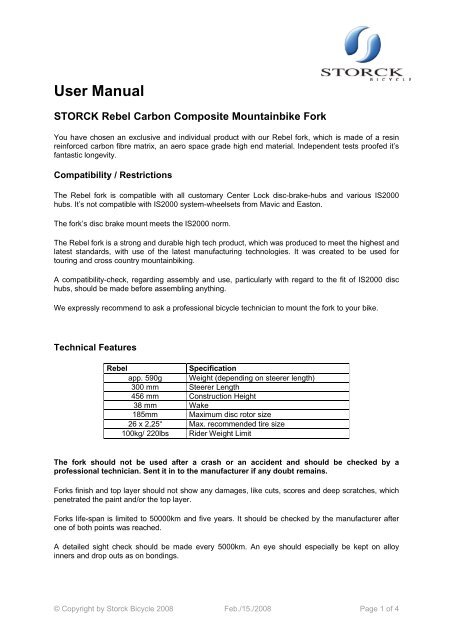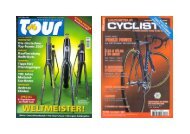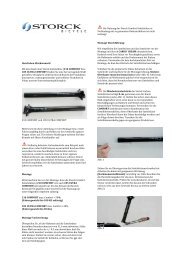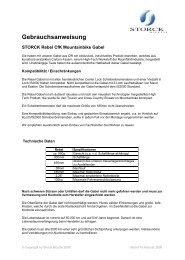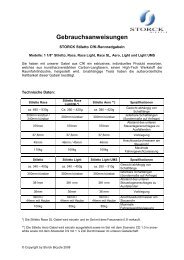Create successful ePaper yourself
Turn your PDF publications into a flip-book with our unique Google optimized e-Paper software.
<strong>User</strong> <strong>Manual</strong><br />
STORCK Rebel Carbon Composite Mountainbike Fork<br />
You have chosen an exclusive and individual product with our Rebel fork, which is made of a resin<br />
reinforced carbon fibre matrix, an aero space grade high end material. Independent tests proofed it’s<br />
fantastic longevity.<br />
Compatibility / Restrictions<br />
The Rebel fork is compatible with all customary Center Lock disc-brake-hubs and various IS2000<br />
hubs. It’s not compatible with IS2000 system-wheelsets from Mavic and Easton.<br />
The fork’s disc brake mount meets the IS2000 norm.<br />
The Rebel fork is a strong and durable high tech product, which was produced to meet the highest and<br />
latest standards, with use of the latest manufacturing technologies. It was created to be used for<br />
touring and cross country mountainbiking.<br />
A compatibility-check, regarding assembly and use, particularly with regard to the fit of IS2000 disc<br />
hubs, should be made before assembling anything.<br />
We expressly recommend to ask a professional bicycle technician to mount the fork to your bike.<br />
Technical Features<br />
Rebel Specification<br />
app. 590g Weight (depending on steerer length)<br />
300 mm Steerer Length<br />
456 mm Construction Height<br />
38 mm Wake<br />
185mm Maximum disc rotor size<br />
26 x 2,25“ Max. recommended tire size<br />
100kg/ 220lbs Rider Weight Limit<br />
The fork should not be used after a crash or an accident and should be checked by a<br />
professional technician. Sent it in to the manufacturer if any doubt remains.<br />
Forks finish and top layer should not show any damages, like cuts, scores and deep scratches, which<br />
penetrated the paint and/or the top layer.<br />
Forks life-span is limited to 50000km and five years. It should be checked by the manufacturer after<br />
one of both points was reached.<br />
A detailed sight check should be made every 5000km. An eye should especially be kept on alloy<br />
inners and drop outs as on bondings.<br />
© Copyright by <strong>Storck</strong> <strong>Bicycle</strong> 2008 Feb./15./2008 Page 1 of 4
Warranty<br />
<strong>Storck</strong> warrants for two years from the day of purchase.<br />
Warning!<br />
Not following this manual could lead to a collapse of the fork and other parts.<br />
Collapse of a single part could enable the ride keeping control over his vehicle, which could<br />
lead to serious injuries and death!<br />
<strong>Storck</strong> is not responsible for products which were assembled unprofessional and/or<br />
untechnical.<br />
All <strong>Storck</strong> products should be assembled by professional bicycle technicians using proper<br />
tools.<br />
Assembling<br />
1. First Steps<br />
Ä Check sizes and meassures of fork and headset to make sure, that both fit.<br />
Ä Check headset parts for flash and sharp edges. Remove those with sandpaper. Flashes and<br />
edges could cause a broken steerer through to a notch effect, which could lead to serious<br />
accidents.<br />
Ä Check the stem for flash and sharp edges. Remove those with sandpaper. Use stems with slotclamps<br />
in the back only. Don’t use stems which fit by squeezing or pressing the steerer.<br />
Ä Proof that your stem has an adequate approval for use on a carbon steerer.<br />
2. Preparing the assembling<br />
Ä Prevent scratching and do not roughen the fork steerer surface. Damaging the carbon top layer<br />
could lead to a collapse of the fork.<br />
Ä Put a little grease on the alloy cone of the steerer before pressing on the lower headset race.<br />
Don’t do anything else with the steerer for now. Take care that you use a race in a fitting size.<br />
Ä Use an adequate tool for pressing the crown race on the steerer cone while firmly holding the fork<br />
in one hand. Don’t rest the fork drop outs on a surface while doing this – this could damage<br />
the fork before use.<br />
Ä If massive force is used for pressing the race on the cone, the fork could also be damaged before<br />
use. The diameter of the 1 1/8” fork’s cone: 30,05 ÅÇ0,05mm.<br />
Ä Take fork, headset-parts, spacers and stem and put them in the frame’s head tube to check how<br />
much of the fork’s steerer needs to be cut down. Mark it. Take care that there are max. 2mm<br />
space between the steerer and the top of the stem/cap<br />
Ä Disassemble the parts again.<br />
Ä Rebel forks can be cut to a minimal length of 120mm.<br />
Ä We recommend to protect the saw area with adhesive tape. This prevents splice of carbon fibres.<br />
Use a fresh saw blade and a cutting jig. Take care that you don’t shorten the fork too much.<br />
Ä File or grind down any sharp edges caused by sawing carfully.<br />
Ä The fork is ready to be assembled now.<br />
© Copyright by <strong>Storck</strong> <strong>Bicycle</strong> 2008 Feb./15./2008 Page 2 of 4
3. Mounting of the fork<br />
Ä You already shortened the fork and pressed the race on the crown.<br />
Ä Assemble fork, headset, spacers and stem inside the frame’s headtube.<br />
Ä Fit the provided clamp mechanism to the fork’s steerer.<br />
Ä Adjust the bearing play with tightening the mechanism carefully. Don’t overtighten it – max. 6<br />
Nm torque should be used. (A lot lower torque should be fine for neutralizing the play usually!)<br />
Ä The stem should be tightened with it’s maximum recommended torque, but not with more<br />
than 8 Nm! A higher torque could cause damages and failures of parts, which could<br />
lead to serious accidents.<br />
Ä Get the stem cap off and check if the steerer top ends 2 mm under the top end of the stem.<br />
Leave a spacer away or cut the fork a little more if necessary.<br />
Ä Put in the stem cap again.<br />
Ä Assemble the front brake strictly regarding it’s manufacturer’s guidelines.<br />
Ä Mount the front wheel and check the guidelines of the hub and quick release manufacturer for<br />
advices how to do it properly. Mounting the wheels wrong or wrong handling of the quick<br />
release could lead to life-threatening and fatal accidents.<br />
Ä Adjust the front brake regarding its manufacturer’s guidelines. Missing of proper assembling<br />
could lead life-threatening and fatal accidents.<br />
Ä Check all assembly steps before using your bike again.<br />
Ä A secure fit of front wheel, fork and stem should be checked before each ride by a<br />
twisting test.<br />
Security-relevant notes<br />
Ä Not more than 30mm spacers should be used between headset cap and stem. More spacers<br />
could cause an insecurity of the steerer, which could lead to life-threatening and fatal<br />
accidents.<br />
Ä Usage of perfectly sized and fitting headsets and stems are allowed only. The nominal diameter<br />
of the steerer in the stem’s clamp area is 28,65 ÅÉ0.05mm. Take care that a stems with adequate<br />
measures and clean inners and rims are used and the steerer has the right length (max. 2mm<br />
under the top rim). Sand down flash and sharp edges on the inside of a stem properly.<br />
Fatal and life-threatening accidents could occur through to flash and sharp edges.<br />
Ä Fork’s integrated securing against accidental loss of the wheel should not be filed down in any<br />
case. Loose all screws before aligning fork and wheel.<br />
Information<br />
Every single fork is a unique handmade product. Carbon fibres are laid regarding an optimized<br />
layering plan into a negative mould. Alloy inners are integrated where necessary. Resin, pressure and<br />
heat create a monocoque. A supporting structure is created on the outside this way, just where it<br />
makes sense from the technical view. This allows combining an extremely low weight with ultra high<br />
stiffness and durability.<br />
Small tolerances in finish and appearance, like tiny air pockets or uneven fibre run, are caused by the<br />
handwork and don’t cause any quality or performance problems.<br />
Single forks are checked by assembling them for test reasons sometimes. Small marks on the surface,<br />
caused by this circumstance can’t be avoided. These marks don’t cause any quality leak too.<br />
© Copyright by <strong>Storck</strong> <strong>Bicycle</strong> 2008 Feb./15./2008 Page 3 of 4
Care Instructions<br />
Common lacquer caring products with or without silicon and water with a little rinsing agent are fine for<br />
cleaning the fork. Don’t rub aggressively and take care, that care products don’t stay to long on the<br />
surfaces.<br />
Any chemicals like thinners, alcohol, acetone, white gas should not be used for cleaning carbon<br />
products.<br />
We recommend using properly tested and approved bicycle clean and care products, recommended<br />
and stored by your bicycle dealer.<br />
Wir wünschen Ihnen viel Freude mit diesem technisch hochwertigen Produkt!<br />
Please contact your professional bicycle dealer or the local distributor (we<br />
show them on our website) for questions, especially regarding service and<br />
warranty.<br />
<strong>Storck</strong> <strong>Bicycle</strong> <strong>GmbH</strong><br />
Carl-Zeiss-Str. 4<br />
D-65520 Bad Camberg<br />
Germany<br />
www.storck-bicycle.de<br />
info@storck-bicycle.de<br />
Tel. +49-6434-9094-0<br />
Fax +49-6434-9094-11<br />
© Copyright by <strong>Storck</strong> <strong>Bicycle</strong> 2008 Feb./15./2008 Page 4 of 4


